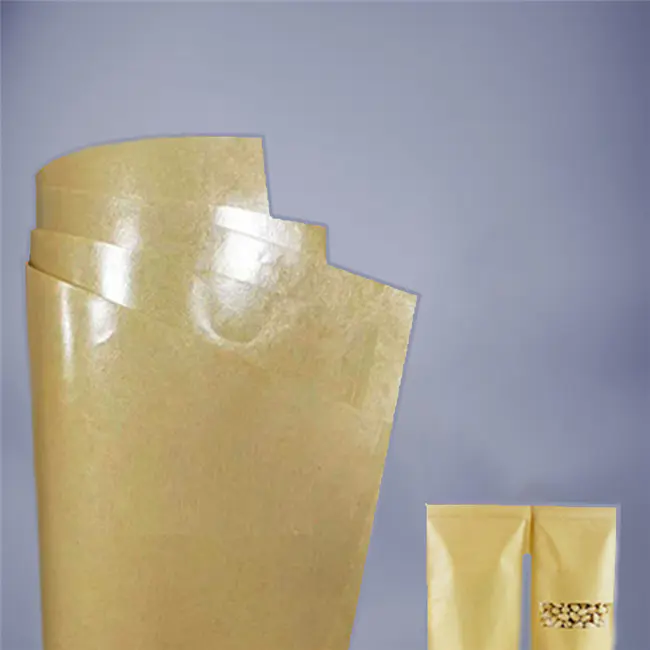Candy Twist Film
Material:Plastic Film
As the global demand for sustainable development and environmentally friendly materials increases, Paper-Plastic Composites (Paper-Plastic Composite), as a new type of composite material, is gradually becoming an important choice in packaging, construction and other industrial fields. This material combines the recyclability of paper and the durability of plastic, not only meeting the needs of modern industry for high-performance materials, but also providing a feasible solution for reducing environmental pollution.
Environmental Protection
The core advantage of paper-plastic composites lies in their environmental protection characteristics. Paper comes from natural wood or recycled fibers, which is degradable and renewable; while the plastic part can be recycled and reused to further reduce the environmental burden. Compared with pure plastic materials, paper-plastic composites significantly reduce the generation of non-degradable waste.
Lightweight and High Strength
While maintaining lightweight, paper-plastic composites have high mechanical strength and tear resistance. This feature makes it perform well in scenarios where weight and durability need to be taken into account.
Waterproof and Moisture-proof

The addition of the plastic layer gives paper-plastic composites excellent waterproof and moisture-proof properties, overcoming the shortcomings of traditional paper that is easy to absorb water and deform. This makes it very suitable for packaging and building materials in humid environments.
Printing and Decorative Properties
The surface of paper-plastic composite materials is smooth and easy to print, and can achieve high-precision pattern and text presentation. At the same time, its appearance can be designed to be matte, glossy or other special textures according to needs to enhance the visual appeal of the product.
Versatility
By adjusting the ratio of paper and plastic and the processing technology, paper-plastic composite materials can have multiple functions such as barrier properties, heat resistance, and UV resistance, which are suitable for the needs of different industries.
Manufacturing Process and Technology
The production process of paper-plastic composite materials involves a variety of advanced technologies and equipment. The following are the main manufacturing processes:
Coating method
A layer of plastic resin is applied to the surface of paper, and then heated and cured to form a composite material. This method is simple to operate and suitable for mass production. It is often used to make food packaging bags and labels.
Lamination method
Plastic film and paper are bonded together under high temperature and high pressure to form a strong composite structure. Lamination method is suitable for products that require higher strength and waterproof performance, such as building materials and industrial packaging.
Coextrusion method
The molten plastic and paper are extruded and combined at the same time to form an integrated composite material. This method can achieve a more uniform bonding effect, but it has high requirements for equipment and technology.
Post-processing technology
In order to enhance the functionality of paper-plastic composite materials, post-processing processes such as surface coating, embossing or thermoforming can also be performed. For example, antibacterial coatings or flame retardants can be added to meet the needs of specific uses.
Application areas of paper-plastic composite materials
Packaging industry
Paper-plastic composite materials are widely used in the packaging of food, beverages, cosmetics and pharmaceutical products. Its waterproof performance and printability make it an ideal packaging material, and its environmentally friendly characteristics also meet consumers' demand for green packaging.
Building materials
In the construction field, paper-plastic composite materials are used to make wall panels, floors, ceilings and insulation materials. Its light weight and high strength reduce the building load, while its moisture-proof performance prolongs its service life.
Logistics and transportation
Pallets, boxes and cushioning materials made of paper-plastic composite materials are both light and durable, and can effectively protect goods from moisture and impact, especially suitable for long-distance transportation and warehousing.
Home and decoration
Paper-plastic composite materials can be used to make furniture surfaces, decorative panels and desktop films. Its diverse appearance design and good wear resistance make it an ideal choice for modern home decoration.
Agriculture and Horticulture
In the agricultural field, paper-plastic composites are used as seedling trays, mulch films and greenhouse covering materials. Its biodegradability and waterproof properties help improve agricultural production efficiency and reduce environmental pollution.
Market Trends and Development Prospects
With increasingly stringent environmental regulations and increasing consumer environmental awareness, the paper-plastic composite market is ushering in opportunities for rapid growth. Here are a few trends worth paying attention to:
Circular Economy and Sustainable Development
In the future, paper-plastic composites will use more renewable resources and recyclable plastics to further reduce carbon footprint and environmental impact.
Technological Innovation
The application of new processing technologies and functional additives will enhance the performance of paper-plastic composites, such as enhancing their barrier properties, heat resistance and antibacterial properties.
Customized Solutions
For different industries and application scenarios, paper-plastic composite manufacturers will provide more customized products to meet the personalized needs of customers.
Global Expansion
With the rise of emerging markets, paper-plastic composites will be more widely used in Asia, Africa and South America, especially in the rapidly developing packaging and construction industries.
With its environmental protection, versatility and wide range of applications, paper-plastic composites are becoming an indispensable part of modern industry and daily life. From packaging to construction, from logistics to home decoration, its unique properties enable it to adapt to a variety of complex scenarios. In the future, with the advancement of technology and changes in market demand, paper-plastic composite materials will continue to promote the development of environmentally friendly materials and make important contributions to the sustainable development of human society. Whether from the perspective of economic benefits or social benefits, paper-plastic composite materials have shown great potential and are destined to occupy a place in the future material market.